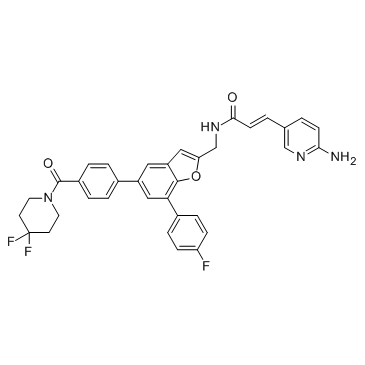1643913-93-2
| Name | (2E)-3-(6-Amino-3-pyridinyl)-N-{[5-{4-[(4,4-difluoro-1-piperidinyl)carbonyl]phenyl}-7-(4-fluorophenyl)-1-benzofuran-2-yl]methyl}acrylamide |
|---|---|
| Synonyms |
2-Propenamide, 3-(6-amino-3-pyridinyl)-N-[[5-[4-[(4,4-difluoro-1-piperidinyl)carbonyl]phenyl]-7-(4-fluorophenyl)-2-benzofuranyl]methyl]-, (2E)-
(2E)-3-(6-Amino-3-pyridinyl)-N-{[5-{4-[(4,4-difluoro-1-piperidinyl)carbonyl]phenyl}-7-(4-fluorophenyl)-1-benzofuran-2-yl]methyl}acrylamide PAK4-IN-1 KPT-9274 |
| Description | KPT-9274 is an orally bioavailable, dual PAK4/Nicotinamide phosphoribosyltransferase (Nampt) inhibitor, with IC50s less than 100 and 120 nM, respectively. |
|---|---|
| Related Catalog | |
| Target |
PAK4:100 nM (IC50) Nampt:120 nM (IC50) |
| In Vitro | KPT-9274 attenuates the PAK4/β-catenin pathway, results in NAD depletion, and attenuates viability, invasion, and migration in several RCC cell lines. Inhibition of NAMPT in a cell-free enzymatic assay using recombinant NAMPT shows an IC50 of approximately 120 nM for KPT-9274. KPT-9274 attenuates G2–M transit and induces apoptosis in RCC cell lines[2]. |
| In Vivo | KPT-9274 demonstrates a decrement of xenograft growth comparable with that of sunitinib. There are minimal KPT-9274 effects on the normal human RPTECs and no apparent toxicity in vivo. KPT-9274 is currently being investigated in a phase I human clinical trial of patients with advanced solid malignancies and NHL[2]. |
| Kinase Assay | For the effect of KPT-9274 on NAMPT activity, recombinant NAMPT activity is measured using a coupled-enzyme reaction system. Briefly, NAMPT is incubated with KPT-9274, in the presence of ATP, nicotinamide, phosphoribosyl pyrophosphate (PRPP), and nicotinamide nucleotide adenylyltransferase 1 (NMNAT1), for 60 minutes at 30°C. Water-soluble tetrazolium salts (WST-1), alcohol dehydrogenase (ADH), diaphorase, and ethanol are then added to each sample for 30 minutes. After the final incubation, the absorbance of the samples is detected at 450 nm[2]. |
| Cell Assay | RCC cell lines in addition to a normal primary renal primary proximal tubular epithelial cell line (RPTEC) are plated in 96-well plates (3,000 cells/well, n=8) and incubated for 72 hours with DMSO or KPT-9274 (0.1, 0.5, 1, 2, 10 μM). The cells are incubated in MTT solution/media mixture. Then, the MTT solution is removed and the blue crystalline precipitate in each well is dissolved in DMSO. Visible absorbance of each well at 540 nm is quantified using a microplate reader[2]. |
| Animal Admin | Mice[2] Male athymic Nu/Nu mice (8 weeks of age and weight 25 g) are injected with 786-O (human RCC) cells subcutaneously in the flank region. When tumor size reaches approximately 225 mm3, animals are randomly assigned to treatment groups and treatments are started (day one). KPT-9274 drug product (30% KPT-9274 API+40% polyvinylpyrrolidone K30+15% methyl cellulose+15% Phospholipon 90G) or vehicle (58% polyvinylpyrrolidone K30+21% methyl cellulose+21% Phospholipon 90G) is administered by oral gavage twice daily for 5 days at 100 and 200 mg/kg twice a day. As a positive control, oral gavage of sunitinib in vegetable oil is given. On day 28 of treatment, the mice are euthanized and the tumor volume is determined[2] |
| References |
[1]. WO2015003166A1 |
| Density | 1.4±0.1 g/cm3 |
|---|---|
| Boiling Point | 857.5±65.0 °C at 760 mmHg |
| Molecular Formula | C35H29F3N4O3 |
| Molecular Weight | 610.625 |
| Flash Point | 472.4±34.3 °C |
| Exact Mass | 610.219177 |
| LogP | 4.74 |
| Vapour Pressure | 0.0±3.2 mmHg at 25°C |
| Index of Refraction | 1.677 |
| Storage condition | -20℃ |
